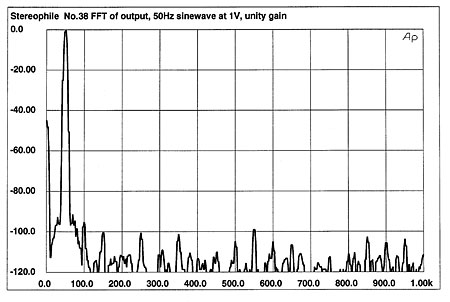| Columns Retired Columns & Blogs |
Mark Levinson No.38 preamplifier Measurements
Sidebar 3: Measurements
The No.38 exhibited extraordinary technical performance on the bench—its measurements were as good as preamplifiers get. First, I measured an input impedance of between 95k ohms and 115k ohms at the balanced inputs, within measurement error of the specified 100k ohms. The single-ended inputs had an input impedance of 90k ohms. With an active volume control, the preamplifier doesn't have the "bomb-proof" input overload characteristic typical of a passive potentiometer. The No.38's input-overload margin (fig.1) was exactly as specified: 16V at the balanced inputs, 8V at the single-ended inputs (these figures for the "knee" in the THD trace). While these aren't particularly high voltages, they're more than adequate for even the highest-output source components.

Fig.1 Mark Levinson No.38, distortion vs input voltage in (from bottom to top) balanced mode, unbalanced mode.
The No.38's maximum gain was 12.8dB with an unbalanced input signal, 18.8dB with a balanced input signal. Both measurements were taken with the volume control set at its maximum.
Output impedance was extremely low, measuring just 6.7 ohms across the band. At these extremely low levels, the cables connecting the device under test to the Audio Precision System One can increase the calculated output impedance. Madrigal claims an output impedance of less than 6 ohms—a figure I believe. This extremely low output impedance is ideal for driving long runs of cable. The output impedance from the tape-out jacks also measured less than 7 ohms at any audio frequency. DC levels were very low, measuring 1.7mV from the balanced outputs, 1.2mV from the single-ended outputs.
The No.38 had a very flat, wide frequency response (fig.2), with the –3dB point falling at 160.5kHz. The signal/noise ratio was the best I've measured in a preamplifier: 99.75dB unweighted in both channels (102.4dB, A-weighted). The single-ended inputs had even lower noise, measuring 102dB unweighted, a figure that increased to an astounding 104.5dB when A-weighted. (The measurement bandwidth was 22Hz–22kHz, referenced to 1V output at just above unity gain.) Shorting the input had no effect on the measured signal-to-noise ratio. These measurements were made with the volume control set at 73.2, 0.1dB above the specified unity gain point. This means that the gain circuit was in the signal path for these S/N measurements.

Fig.2 Mark Levinson No.38, frequency response (right channel dashed, 0.5dB/vertical div.).
Fig.3 is the No.38's crosstalk performance measured from the balanced inputs to the balanced outputs. This extraordinary channel separation—greater than 105dB at 20kHz—was nearly identical when measured from the single-ended inputs to either the single-ended or balanced outputs.

Fig.3 Mark Levinson No.38, crosstalk in balanced mode with undriven input shorted (10dB/vertical div.).
I measured the No.38's THD+noise at two volume positions: 70 (just below where the gain stage is invoked) and 80 (which puts the gain circuit in the signal path). Fig.4 shows the results. The THD+noise was lower with the gain circuit switched in, with a slight increase in noise seen above 10kHz in the bottom pair of traces (both measurements were referenced to 1V output). In either case, the distortion and noise levels were extremely low—better than 0.005% under any conditions.

Fig.4 Mark Levinson No.38, THD+noise vs frequency (from top to bottom): with volume control set to 70; volume control set to 84 (right channel dashed).
Fig.5 is an FFT of the No.38's output when processing a 50Hz sinewave at 1V output, with the unit set at unity gain. The distortion is very low, although the seventh and eleventh harmonics are nearly as high as the sonically benign second and third harmonics. As was expected, given the No.38's extremely low output impedance, there was no change in the distortion spectrum when driving a 100k ohm load compared to a 600 ohm load (not shown).

Fig.5 Mark Levinson No.38, spectrum of 50Hz sinewave, DC–1kHz, at 1V into 100k ohms with volume control set for unity gain (linear frequency scale). Note that the second harmonic at 100Hz is the highest in level, 97dB below the level of the 50Hz fundamental (0.0014%).
The No.38's channel balance was an astonishing 0.01dB at any volume position. This is the lower resolution limit of the Audio Precision System One; the actual channel balance may indeed meet Madrigal's claim of 0.001dB. As indicated in the technical description, a volume control with perfect matching is a big plus in a fully balanced preamplifier; both halves of the balanced signal should have identical gain.
In short, the No.38 has the best bench performance of any preamplifier I've tested. The extraordinarily low noise, wide bandwidth, extreme channel separation, low distortion, and incredibly precise volume-control tracking set new standards in technical performance for a preamplifier.—Robert Harley
- Log in or register to post comments




































